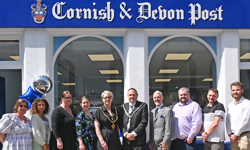Welcome to the year when we commemorate the 100th anniversary of the outbreak of World War I, celebrate a summer of Samba football … and take another lurch towards the demise of newsprint. We are now a mere five years away from 2019, the date when futurist Ross Dawson predicted UK newspapers would become 'insignificant in their current form'. I asked him recently if he stands by the prediction he made in 2010. He does. "In some countries, the pace of extinction seems to be moving faster than I anticipated. However I think for the UK, 2019 is still a pretty decent forecast, so yes I'll stick with that." Whether he is right or not, it is clear that those toiling at the newsroom coalfaces up and down the country will be in for another topsy-turvy year. So I took a gaze into my own crystal ball for clues on what lies ahead for regional newspapers:
An influx of people with new skills
The inescapable challenge is how to make money from digital. We need skilled and motivated people who can sell solutions rather than space. When I arrive in a town, I need to know the restaurants and hotels with prices, location and easy booking. And I want someone to deliver that info. I don't want to go looking for it and I don't want to pay. Without doubt, we will see the further rise of multi-skilled, energetic and entrepreneurial journalists. Equally critical, though, are innovative commercial people who don't simply go back to the usual suspects.
A culture of giving it a go
We have seen paywalls, part-paywalls, subscriptions, eyeball-chasing and attempts to gather meaningful data from the audience. Nobody really knows what works for sure. This will be the year of taking chances, experimenting and creating a culture where people are encouraged to have a go.
A further decline in print revenue
Print revenue is projected to fall by 9.8 per cent. Even if we spring into recovery, big print revenues aren't coming back. Why? One of the most significant recent events for newspapers was Newcastle United demanding payment for player access. It was treated as another maverick move by the Looney Toons' owner Mike Ashley. But it is something far more worrying than that. It is an indication of how newspapers are increasingly regarded. Newcastle are asking the killer questions. What value do the papers bring to the club's business? Who needs who most? And as the differences between print and broadcasting blur, why should some media pay for access while others are handed it by right? I don't expect Newcastle to be the only club to do this. And how long before other businesses ask themselves the same questions?
Changes in frequency
It was sad, but unsurprising, that the end of 2013 was marked by the closure of a city newspaper. The Liverpool Post went from daily to weekly to nowhere in four years. Centres in Newcastle, Leeds, Bristol, Norwich, Ipswich, Dundee, Aberdeen, Cardiff and Plymouth still address the challenge of producing two daily titles, by offering very different newspapers. It's a strategy that largely works … but for how long? There are also more than 30 daily titles selling under 20,000 copies a day, many losing sale by 10 per cent. How long can that be sustained? If one thing is certain in 2014, it is that more titles will become weekly or bi-weekly.
A further look at pricing
The current strategy is to raise cover prices. I am all in favour of the true value of newspapers being reflected in the price … but it’s a struggle to balance that with the inevitable impact on sale. If longevity is the goal, then there may be a role for free newspapers? Advertisers demand reach, and they won't get it from titles read by 5 per cent of the population. Ted Young, formerly editor of MailOnline and London Lite, is now editing the New York Daily News and Daily News America Online. He believes free papers could be an answer: "As a veteran of the brutal free newspaper war in London between Murdoch and Associated, I find it interesting that the Standard is now making money when it was losing millions five years ago and circulation was going down the plug hole. It has done this by remaining a quality paper, which attracts advertising from top brands. There is a lesson. I believe some publishers should take the plunge, go free."
A root and branch review of content
Content is everywhere and our new competitors include Buzzfeed, Yahoo and Google. It's crowded out there. So newspapers must convince people there are real reasons to regularly visit their digital services and compelling reasons to pick up a print copy. Anything on newsprint is out of date – so it needs to bristle with things of beauty and value. Being local, thorough and trusted is a powerful starting position. But what are you giving readers that they really need?
Further cost cutting
MailOnline, the daddy of all websites, made £41m in revenue last year. It is a huge growth … so good news. But it wasn't enough to offset the decline in DMGT's print advertising revenue. So what are the realistic chances of local groups making big revenues from digital in 2014? They will either need to accept a period of substantially reduced profits, while they invest, or find less expensive ways of doing things.
The growth of mobile
There isn't enough space to explore the full impact of mobile growth. Suffice to say, 91 per cent of all people on the planet have a mobile phone and mobile advertising is growing faster than expected. Selling to mobile is a million miles away from selling for print so expect a lot of energy to be devoted to working out how.
There you have it … a year of radical change awaits. Local World is headed up by David Montgomery, who is unequivocal in his digital commitment. Johnston Press digital director Henry Faure Walker takes over the reins as Newsquest chief executive in April and JP itself is headed up by Ashley Highfield, a former vice president of Microsoft. It looks like the stage is set for 2014 to be a milestone in the history of local newspapers - the year they finally become fully-fledged digital, rather that print, businesses.
Newspaper executives give their priorities for 2014
Ted Young, editor, New York Daily News and Daily News America Online: “Publishers have to invest in proper journalism. The 21st century multi-media executive has to balance producing a premium newspaper product every day and provide a sparkling online edition, updated 24/7. The all-important advertisers will buy into this business model for years to come.”
Dominic Fitzpatrick, managing director, The Irish News: “An increasing trend could be the return of newspaper ownership to private companies. The PLC model has, in many cases, proved extremely damaging to local newspapers, as the centre of control has moved further away from the communities they serve. The one-shape-fits-all approach has eroded the personalities of many titles. There are a lot of great newspaper titles in need of some TLC and I hope they receive it, before it is too late.”
Andy Phelan, head of content, Local World: “Journalists have to rethink their roles, editors have to rethink how they use the resource they have. Trust your analytics. If no one is reading your story online, it's a stretch to believe they're lapping it up in print. That will mean we stop writing about certain things and divert reporters towards other less traditional areas - in line with what we know readers are searching for. That doesn't mean we stop doing a proper job of reporting. It means we stop wasting our time writing stories very few people will read.”
Neil Benson, regional editorial director, Trinity Mirror: “We need to be bold about widening our content offering. Local news and sport are still the bedrock but, in isolation, that's not enough. We will be giving our readers - in print and digital – more opportunities to use our brands as a platform for their own news, views and information, which we are convinced will encourage them to visit us more often and stay longer.”
David Rowell, head of editorial learning and development, Johnston Press: “Training will be a key factor as we help journalists develop their thinking further to meet the many cultural changes that this new era of journalism is demanding. One thing is for sure: not changing is simply not an option.”
Chris Bright, outgoing editor, the Jersey Evening Post: “Future success will depend on treasuring the basics of our craft. Even the most obtuse of managements will come to accept that they will not have a business for long if they fail to invest again in journalism and editorial quality.”
Blanche Sainsbury, commercial director, Local World: “The challenge is monetising the increase in digital audience, developing this as the core of our business. We should market ourselves to our advertisers as media brands with multiple platforms, rather than print brands with an online offer. We need to skill up our staff to become experts in digital and social marketing to best advise customers.”
Peter Barron, editor, The Northern Echo: “The next twelve months will see an acceleration in the transition to digital, with investment in better multi-media publishing systems, and greater emphasis on news as it happens. The challenge will be to manage the speed of change while protecting quality and not forgetting that our printed products remain a crucial part of the business.”
Mike Gilson, editor, Belfast Telegraph: “Do we have enough reporters lifting the rocks to find out what's underneath? Do we have enough newspapers dedicated to telling readers / users what they didn't know rather than giving them confirmations? Many newspapers no longer fill this brief. Too many are poor and are contributing to their own decline. Much of the problem is economic but unless we reappraise the fundamentals and not just gawp at the shiny new stuff, we are going to be in trouble. Beginnings of a correction in 2014? I'm not holding my breath.”












